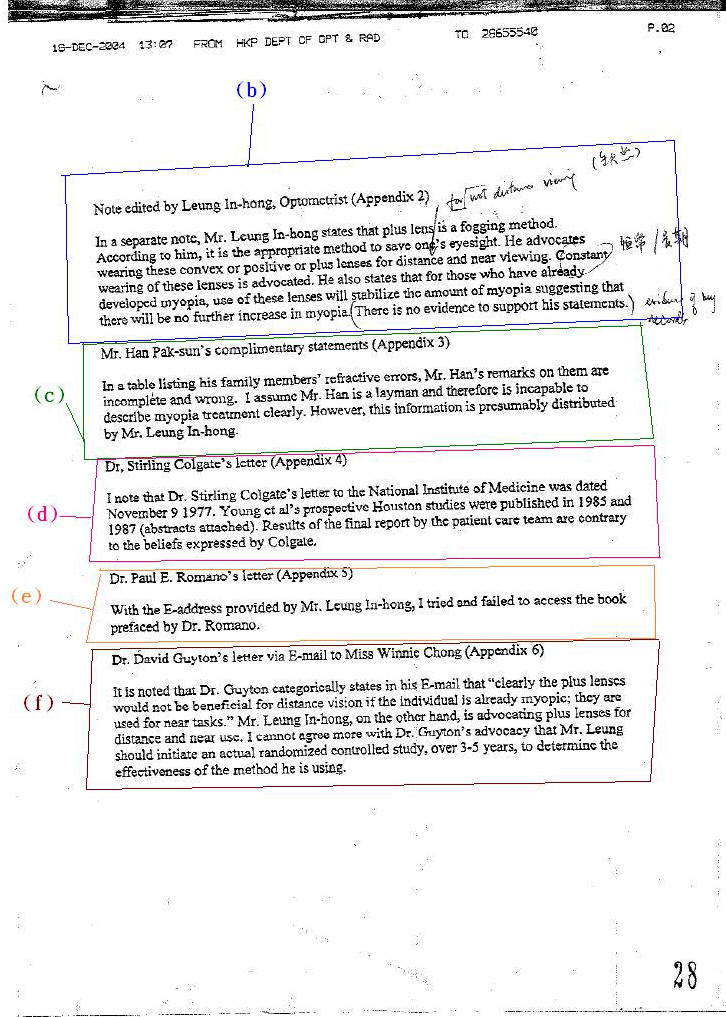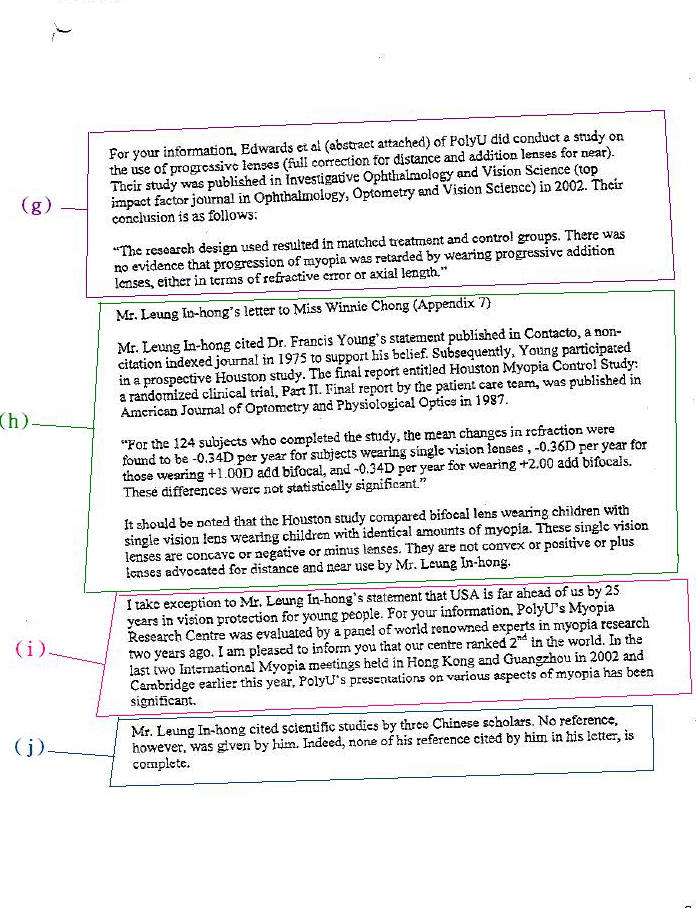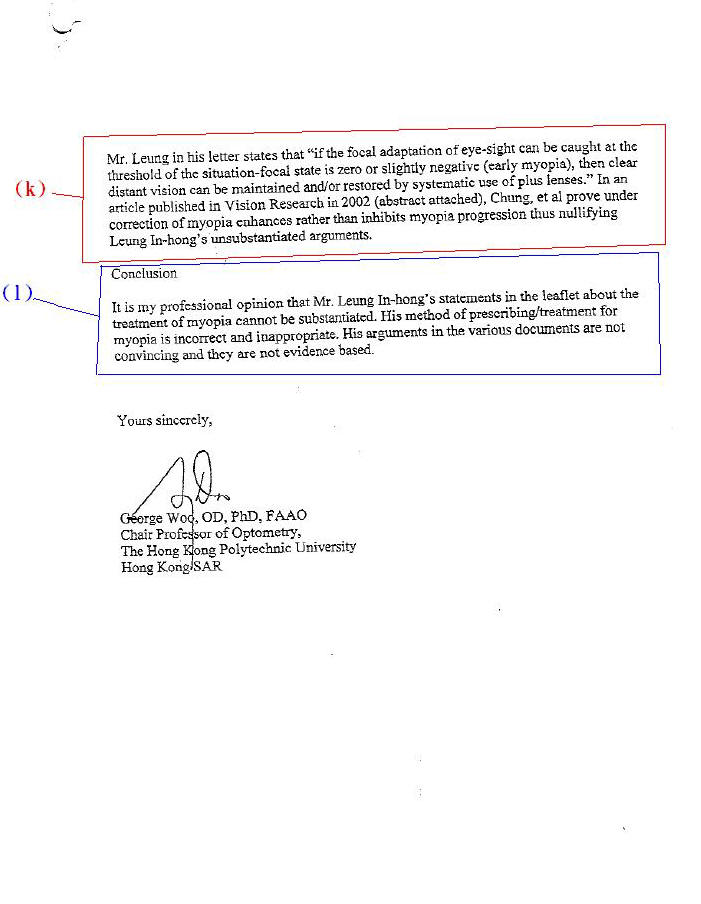
香港視光師管理委員會
聆訊視光師梁彥康事件
奧迪•白朗回應胡志誠教授的觀點
針對胡志誠教授的信,本網站邀請 www.myopiafree.com 的網主奧迪•白朗,針對胡教授的觀點逐點回應。
(由於時間緊迫,中文譯本,稍後才會推出,敬請見諒。)

George = Professor George Woo(胡志誠教授)
Otis = Otis S. Brown(奧迪•白朗)
HAN = HAN Bossino(韓柏新)
ODs = 視光師的簡稱
(a)
George: Having read several documents pertaining
to Mr. Leung's view on his method of prescribing for myopia, I write to render my opinion.
George: Chinese pamphlet on myopia prevention
(Appendix 1)
George: Mr. Leung's statements and claims are
misleading and incorrect. He claims that by wearing convex lenses from 1 to 3 years when someone is developing myopia are not based on evidence.
Otis: Direct scientific evidence concerning the
dynamic behavior of the fundamental eye? It is obvious that this man totally ignores such evidence. It is clear that at least the objective, scientific facts supports the "second-opinion", even as the "majority opinion" advocates continued ignorance of these objective, scientific facts. This man advocates that the "traditional" minus-lens be continued, and "objection" to its use be completely surpressed. This board has the power to enforce their judgment on Steve Leung
George: In the pamphlet, he does not provide any
figures for the amounts of myopia when these convex lenses are prescribed. The message is that concave are detrimental to myopia and only convex lenses should be prescribed for myopia. This is contrary to any conventional treatment for myopia. His statements that 90% of myopic patients are receiving the wrong treatment is incorrect and misleading.
Otis: This depends on who is "misleading" whom.
While I do not expect any OD to put himself at "professional risk" in order to offer a "second opinion", I would at least expect ALL ODs to be sufficiently informed to DISCUSS this alternative with a person -- before that first minus lens is applied. At least the person would have an option to explore more completely the concept of prevention -- and use it effectively if that were his choice. I think all "professionals" have this obligation to offer that discussion. This man judges he has no obligation of that nature. I urge you to continue to offer this choice to a person on the threshold -- with no obligation to go beyond that point.

(b)
George: Note edited by Mr. Leung (Appendix 2)
George: Mr. Leung states that the plus is a
fogging method. According to him, it is the appropriate method to save one's eyesight. He advocates wearing these convex lenses for distance and near viewing. Constant wearing of these lenses is advocated.
Otis: The decision to use the plus "aggressively"
must depend on the person's "choice" after he has time to review the issues and the experimental data itself. The actual use of the plus would follow this type of review. Effective use of the plus (for prevention) does require a "strong will", and a certain belief that the method can be successful for the person who is going "all-out" to use the plus correctly.
George: He also states that for those who have
already developed myopia, use of these lenses will stabilize the amount of myopia suggesting that there will be no further increase in myopia. There is no evidence to support his statements.
Otis: Again, this depends on the scientific
background of the man making the statement. A man who has been saturated with the concept that the eye's refractive status is isolated from its visual environment, is going to make that type of sweeping, un-proven statement -- while totally ignoring a massive amount of direct-experimental data to the contrary. As long as exclusively "ODs" sit on that "board" you
(Steve Leung) have no chance of fighting this issue. If the board has some true-scientists, and some people of the "second opinion" concept you (Steve Leung) might stand a better chance.
(c)
George: Mr. Han's complimentary statements.
George: In a table listing his family members'
refractive errors. Mr. Han's remarks on them are incomplete and wrong. I assume Mr. Han is a layman an therefore is incapable to describe myopia treatment clearly. However, this information is presumably distributed by M. Leung.
HAN: Hey. I wrote those statements by
myself. How can you said that my remarks on my family members' are wrong? Do
you know my family?
(d)
George: Dr. Stirling Colgate's letter
George: I note that Dr. Colgate's letter to the NIH was dated November 8 1977. Young et al's prospective Houston studies were published in 1985 and 1987. Results of the final report by the patient care team are contrary to the belief expressed by Dr. Colgate.
Otis: I have every confidence in Stirling's
statement of effective prevention when the plus is forcefully used BEFORE the minus lens is used. As the very minimum, it must be recognized that no "perfect proof" can be supplied for any opinion.
Otis: Francis Young was only "partially" involved in the Houston study and did not agree with the protocol --nor
the results since they contradicted his own results -- which demonstrated that nearsightedness COULD BE PREVENTED on the threshold. This "George" is very selective in what he chooses to report. A "second opinion" board member would be of great value in this review.
(e)
George: Dr. Paul E Romano's letter
George: With the E-address provided by Mr. Leung,
I tried and failed to access the book prefaced by Dr. Romano.
(f)
George: It is noted that Dr. Guyton
categorically states in his email that "clearly the plus lenses would not be beneficial for distance vision if the individual is already myopic; they are used for near tasks. Mr. Leung, on the other hand, is advocating plus lens for distance for near use. I cannot agree more with Dr. Guyton's advocacy that Mr.Leung should initiate an actual randomized controlled study, over 3-5 years, to determine the effectiveness of the method he is using.
Otis: I advocate that the person himself (pilot)
be sufficiently educated so that he be empowered to make both the eye-chart and refractive measurements himself. (i.e., an engineering study at a four year college). Given Francis Young's results, I have no doubt that pilots on the threshold could clear their distant vision from 20/40 to 20/20, with intensive effort with the plus. Since other young men have already done this -- a formalized study -- conducted by engineer-scientists could certainly reproduce this obvious success. The issue will be "who is in control"? If engineers -- I have high confidence in success. If this "George" I am certain the effort will "fail".

(g)
George: For your information, Edwards et al of
Poly U did conduct a study on the use of progressive lenses (full correction for distance and addition for near). The conclusion -- "The research design used resulted in matched treatment and control groups. There was no evidence that progression of myopia was retared by wearing progressive addition lens, either in terms of refractive error or axial length"
Otis: Even given the fact that the "children" were
too young to "follow instructions", Professor Francis Young's study demonstrated that the "plus" group showed a "down" rate of zero diopters (i.e., myopia development effectively stopped). When two studies contradict each other, neither one can be "right" and you must look at DIRECT experimental data taken on an "input" versus "output" basis on adolescent primates. This experiment proved what the "bifocal studies" could never prove -- that the natural eye always moves "down" when you place it in a more-confined visual environment. Obviously this "professor" NEVER wants these scientific facts to see the light of day.
(h)
George: Mr. Leung's letter to Miss Chong
George: Mr. Leung cited Dr. Young's statement
published in Contacto, a non-citation indexed journal in 1975 to support his belief. Subsequently, Young participated in a prospective Houston study. The final report entitled Houston myopia control study: a randomized clinical trial, Part @. Final report by the patient care team, was published in Am. J of Optometry and Physiological Optics 1987.
George: "For the 124 subjects who completed the
study, the mean changes in refraction were found to be -0.34 per year for subjects wearing single vision lenses, - 0.36D per year for those wearing +1.00 addition, and - 0.34 per year for wearing +2.00 add bifocal. These differences were not statistically significant."
Otis: As Francis Young pointed out, they use a
"small plus" in the lower segmement. Very often the young child would avoid looking THROUGH the plus. For this reason the study was not "controlled" in any scientific sense.
Otis: Francis Young's Pullman study used a
strong, high-placed plus, where the kid HAD TO LOOK THROUGH THE PLUS. I remember the numbers to be about 200+, where the half wearing the plus showed no "down" movement, were the single-minus when "down" at a steady -1/2 dipoter per year.
George: It should be noted that the Houston study
compared bifocal lens wearing children with single vision lens wearing children with identical amount of myopia. These single vision lenses are concave. They are not convex lenses advocated for distance and near use by Mr.
Leung.
Otis: At the very minimum, the fact that Dr.
Young's study produced a profoundly different result should ALWAYS be discussed. Francis Young did not think much of the "Houston" study for the reasons stated above.
(I)
George: I take exception to Mr. Leung's
statements that USA is far ahead of us by 25 years in vision protection for
young people. For your information, Poly U's myopia research center was evaluated by a panel of world renowned experts in myopia research two years ago.
Otis: Yes, and 92 percent of the
MDs on Taiwan are myopic. Does this sound like effective "preventive" work. Or blindly following the "traditional" method of the last 400 years -- regardless of consequences, or ignoring the massive amount of DIRECT, SCIENTIFIC data that suggests that the traditional minus lens creates very serious long-term vision problems for all of us.
George: I am pleased to inform you that our center
ranked 2 in the world. IN the last two international myopia meetings held in HK and Guagzhou in 2002 and Cambridge earlier this year, Poly U's presentations on various aspects of myopia has been significant.
Otis: And with all their impressive "expertise"
how much myopia have they "prevented"?
HAN :Spending money to carry research, but no way
to suppress the wide spread of myopia -- Poly U's Center rank 2 in the world,
but Hong Kong is the No.1 dense myopic population in the World. Do you feel SHAME?
(J)
George: Mr. Leung cited scientific studies by
three Chinese scholars. No reference, however, was given by him. Indeed, none of his reference cited by him in his letter, is complete.
HAN :
Dr. Xu Guang Dis(徐廣第),
Dr. Jung Yun Xin (鐘潤先), Dr. Wang Fang Yun(汪芳潤),
all of them are most famous eye doctor in China. Maybe George
don't read any Chinese ophthalmic books at
all.

(K)
George: Mr. Leung in his letter states that "...if
the focal adaptation of eye-sight can be caught at the threshold of the situation-focal status is zero or slightly negative (early myopia), then clear distance vision can be maintained/or restord by systematic use of plus lenses" In an article published in Vision Research in 2002, Chung et al proved under-correction of myopia enhances rather inhibits myopia progression thus nullifying Leung's insubstantiated arguments.
Otis: Here again the "George" is selectively
reporting what he wants to believe. A person who is "impartial" would have no problem discussing Francis Young's Pullman study. This is a matter of selective bias and preferred ignorance.
George: It is my professional opinion that
Mr. Leung's statements in the leaflet about the treatment of myopia cannot be substantiated.
Otis: Fine, I accept that George's statement is
the "majority opinion". In no sense should the George's statement be allowed to suppress the concept that the natural eye is "dynamic", nor does his statement PROVE that actions should be taken against you to "shut you up -- or shut you down". But we are talking about naked political power of the Board" -- and not about scientific truth as it concerns the dynamic behavior of the fundamental eye.
George: His method of prescribing/treatment for
myopia is incorrect and inappropriate. His arguments in the various documents are not convincing and they are not evidence based.
Otis: The fact that there is a "majority opinion"
and "second opinion" means that "arguments and documents" are not "convincing" to EITHER group. That does not mean that either group is wrong. It is just that two contractory methods must exist side-by-side for some time into the future.
Otis: In the long history of medicine (and
science) this is about the only method that allows for necessary and fundamental scientific change.
回到第二場現場直擊報導↓
回到預防近視網網站負責人評論按這裡↓
回到事件簿首言
| 